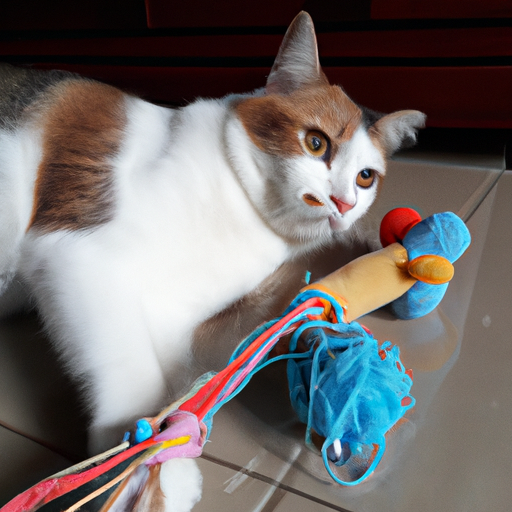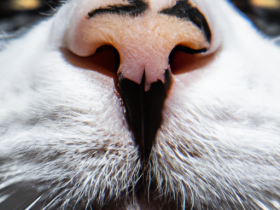“My Cat’s Got Better Things to Do – Like Sleep!”
Introduction
My cat is my best friend, but sometimes it can be hard to get them to play with me. Cats are independent creatures and they don’t always want to do what we want them to do. There are a few reasons why my cat might not be playing with me, such as stress, boredom, or even health issues. Understanding why my cat isn’t playing with me can help me better understand my cat and how to make them happy.
The Reasons Why Your Cat May Not Be Interested in Playing With You
Cats are known for their independent nature, and while they may enjoy spending time with their owners, they may not always be interested in playing. If your cat is not engaging in playtime, there are a few potential reasons why.
First, cats may not be interested in playing if they are feeling unwell. If your cat is not feeling well, they may not have the energy or desire to engage in play. If you suspect your cat is not feeling well, it is important to take them to the vet for a check-up.
Second, cats may not be interested in playing if they are feeling stressed or anxious. Cats can become stressed or anxious due to changes in their environment, such as a new pet or a move to a new home. If your cat is feeling stressed or anxious, it is important to provide them with a safe and comfortable environment.
Third, cats may not be interested in playing if they are not getting enough exercise. Cats need regular exercise to stay healthy and happy, and if they are not getting enough, they may not be interested in playing. It is important to provide your cat with plenty of opportunities to exercise, such as playing with toys or going for walks.
Finally, cats may not be interested in playing if they are not getting enough mental stimulation. Cats need mental stimulation to stay engaged and interested in their environment, and if they are not getting enough, they may not be interested in playing. Providing your cat with interactive toys and puzzles can help to keep them mentally stimulated.
In conclusion, cats may not be interested in playing for a variety of reasons, including feeling unwell, feeling stressed or anxious, not getting enough exercise, or not getting enough mental stimulation. If your cat is not interested in playing, it is important to take the time to assess the situation and provide them with the care and attention they need.
How to Encourage Your Cat to Play With You
Playing with your cat is a great way to bond and provide them with mental and physical stimulation. Here are some tips to help you encourage your cat to play with you:
1. Use the right toys. Cats love toys that move, such as feathers, strings, and balls. Choose toys that your cat can chase and pounce on.
2. Make playtime fun. Cats are naturally curious and love to explore. Make playtime fun by hiding toys around the house or using interactive toys that require your cat to work for their reward.
3. Be patient. Cats can be shy and may take some time to warm up to you. Give your cat plenty of time to get comfortable with you and the toys before expecting them to play.
4. Be consistent. Make playtime a regular part of your cat’s routine. This will help them to look forward to it and make it easier for them to get into the habit of playing with you.
5. Reward your cat. Cats love treats and praise. When your cat plays with you, reward them with a treat or a few words of praise. This will help them to associate playing with you with something positive.
By following these tips, you can help your cat to become more comfortable with playing with you and enjoy the time you spend together.
Understanding Your Cat’s Body Language: What Does it Mean When Your Cat Refuses to Play?
When your cat refuses to play, it can be a sign that something is wrong. Cats are naturally playful creatures, so if your cat is not engaging in playtime activities, it could be a sign that they are feeling unwell or stressed.
It is important to pay attention to your cat’s body language when they are refusing to play. If your cat is avoiding eye contact, has their ears flattened against their head, or is displaying other signs of fear or anxiety, it could be a sign that they are feeling stressed or scared. If your cat is displaying these signs, it is important to take steps to reduce their stress levels and create a safe and comfortable environment for them.
If your cat is displaying signs of illness, such as lethargy, loss of appetite, or vomiting, it is important to take them to the vet for a check-up. Refusing to play could be a sign of an underlying medical condition, so it is important to get your cat checked out as soon as possible.
In some cases, your cat may simply be bored or uninterested in playing. If this is the case, it is important to provide your cat with stimulating toys and activities to keep them entertained. You can also try introducing new toys or activities to keep your cat engaged and interested in playtime.
Overall, if your cat is refusing to play, it is important to pay attention to their body language and take steps to reduce their stress levels or provide them with stimulating activities. If your cat is displaying signs of illness, it is important to take them to the vet for a check-up.
The Benefits of Playing With Your Cat
Playing with your cat can be a great way to bond with your pet and provide them with mental and physical stimulation. Cats are naturally curious and playful creatures, and playing with them can help to keep them healthy and happy. Here are some of the benefits of playing with your cat:
1. Mental Stimulation: Playing with your cat can help to keep them mentally stimulated. Cats are intelligent creatures and need to be kept mentally active in order to stay healthy. Playing with your cat can help to keep their minds sharp and can help to prevent boredom.
2. Physical Exercise: Playing with your cat can help to provide them with physical exercise. Cats need to stay active in order to stay healthy, and playing with them can help to keep them fit and active.
3. Bonding: Playing with your cat can help to strengthen the bond between you and your pet. Cats are social creatures and need to feel loved and appreciated. Playing with your cat can help to show them that you care and can help to create a strong bond between you and your pet.
4. Stress Relief: Playing with your cat can help to reduce stress levels. Cats are sensitive creatures and can pick up on their owner’s stress levels. Playing with your cat can help to reduce stress levels and can help to create a calming environment for both you and your pet.
Playing with your cat can be a great way to bond with your pet and provide them with mental and physical stimulation. It can help to keep them mentally active, physically fit, and can help to strengthen the bond between you and your pet. Playing with your cat can also help to reduce stress levels and can help to create a calming environment for both you and your pet.
How to Make Playtime Fun for Both You and Your Cat
Playtime is an important part of a cat’s life, and it can be a great way to bond with your pet. To make playtime fun for both you and your cat, there are a few things you can do.
First, make sure you have the right toys. Cats love to chase and pounce, so look for toys that encourage these behaviors. Catnip-filled toys, feather wands, and laser pointers are all great options.
Second, create an environment that encourages play. Make sure your cat has plenty of space to move around and explore. You can also set up a few obstacles, such as cardboard boxes or paper bags, for your cat to climb and hide in.
Third, be creative. Cats love to explore and discover new things, so try to come up with new ways to engage your pet. You can hide treats around the house for your cat to find, or create a homemade obstacle course.
Finally, be patient. Cats can be unpredictable, so don’t expect your pet to respond to every game you play. If your cat isn’t interested, take a break and try again later.
By following these tips, you can make playtime fun for both you and your cat. With a little creativity and patience, you can create a bond with your pet that will last a lifetime.
Conclusion
It is likely that your cat does not play with you because they are not used to it. Cats are naturally independent animals and may not be used to being around humans or playing with them. It is important to give your cat time to adjust to your presence and to build trust with them. With patience and understanding, you can eventually build a strong bond with your cat and they may even start to play with you. As a pet owner, it can be extremely disheartening to watch your furry friend ignore you when you’re trying to play. It’s no surprise that many people own cats for their playful personalities, but what do you do if your cat doesn’t seem to have any interest in you?
First and foremost, it’s important to understand that cats are solitary creatures. Unlike dogs, cats are not as dependent on their owners for companionship. They have a tendency to be independent and aloof, so it’s normal for cats to be less interested in playing with you than a dog would be.
Second, cats can be easily overwhelmed by too much stimulation. If you’re constantly trying to get your cat to play, it can be too much stimulation and they may just not want to participate. This can be especially true if your cat is a senior or a rescue.
Third, cats may not be interested in the type of play you’re offering. If they’re not interested in chasing a feather toy or batting around a toy mouse, they’re not likely to be interested in other types of play. Try to think of different types of toys that your cat might find more interesting.
Finally, cats can become bored of the same toys and activities. If you’ve been playing with the same toys for weeks or months, your cat may have simply become bored with them. Try to switch up the toys and activities you’re offering your cat to keep things interesting.
In conclusion, it’s normal for cats to not be as interested in playing as dogs. If your cat is not playing with you, it’s important to consider factors such as stimulation, boredom and type of play. With some patience and trial and error, you should be able to find activities that your cat loves.
What can I do to get my cat to play with me?
1. Try using interactive toys – cats love toys that move, make noise, and respond to their play. These include wand toys, laser pointers, and battery-operated toys.
2. Make time for play – cats need regular playtime as part of their daily routine. Set aside 10-15 minutes a day for playtime and stay consistent with it.
3. Engage your cat – when playing with your cat, use an interactive toy or your hands to engage them and make sure they stay interested.
4. Provide hiding spots – cats like to play hide and seek, so adding hiding spots around the house can encourage play.
5. Give treats or food rewards – cats are motivated by food, so offering treats or food rewards during playtime can encourage them to keep playing.
What toys should I get to encourage my cat to play?
1. Catnip toys: These toys have stimulants that cats love, and they can help your cat stay active and playful.
2. Feather toys: Feathers are a great way to get your cat to swat and chase.
3. Laser toys: These toys can provide hours of entertainment for your cat as they chase the light around the room.
4. Interactive toys: These toys come with food or treats in them, and your cat has to figure out how to get them out. This encourages problem-solving skills and keeps them entertained.
5. Puzzle toys: These toys have treats hidden inside, so your cat has to figure out how to get them out. This encourages problem-solving skills and keeps them entertained.








Leave a Reply
View Comments